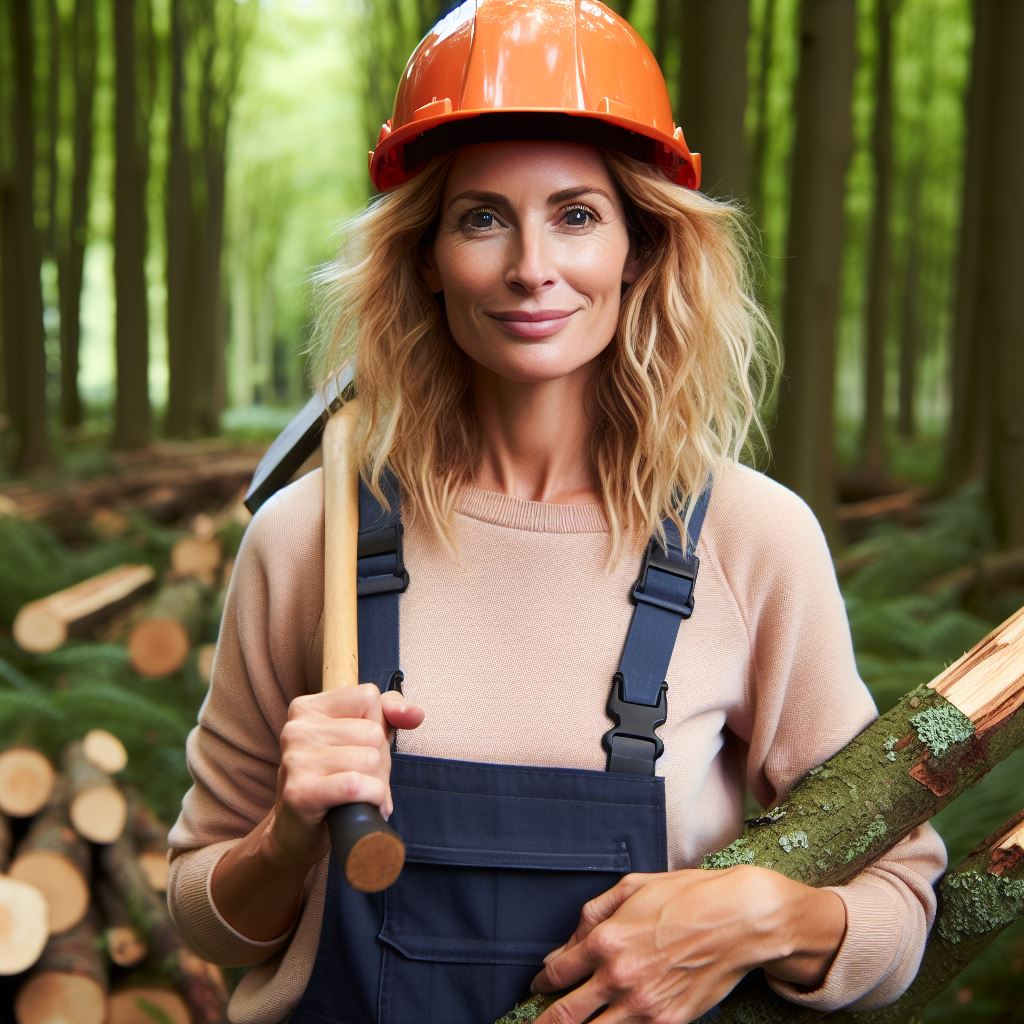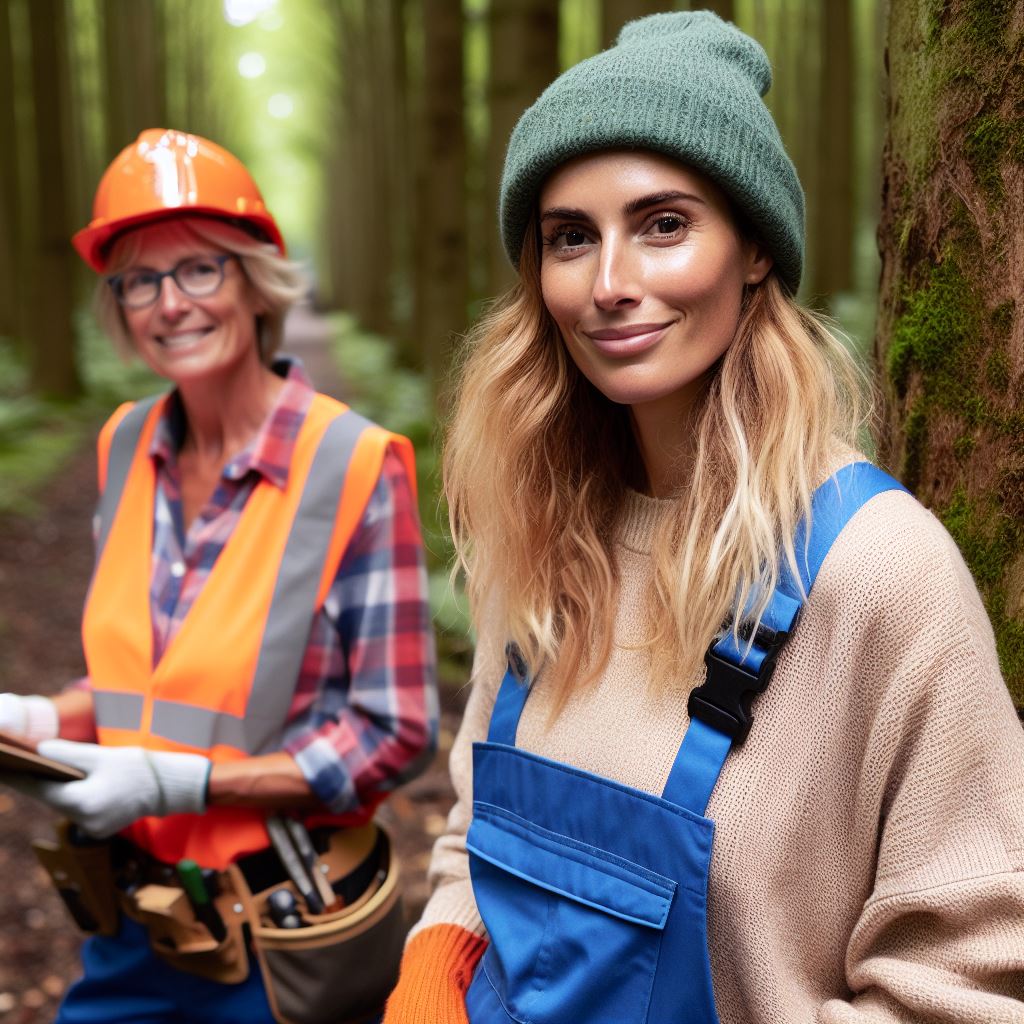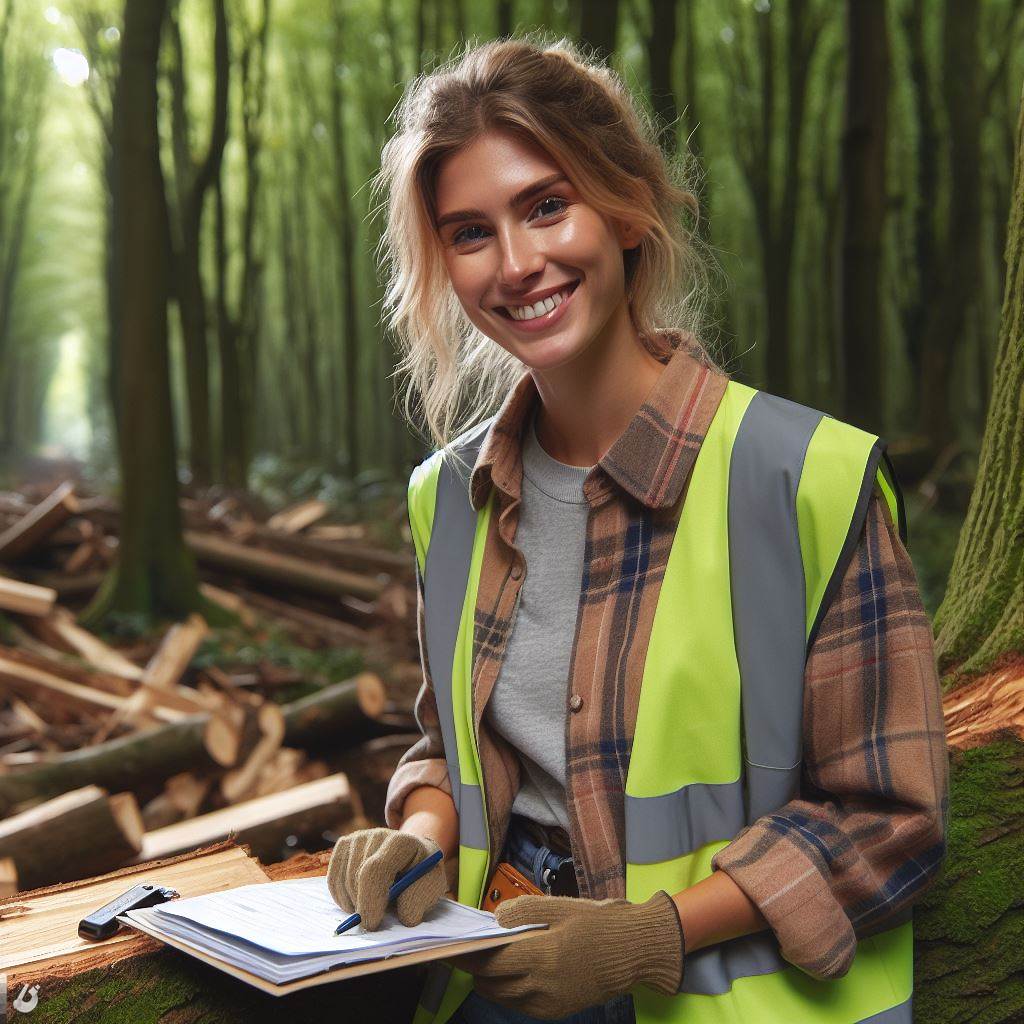Introduction
Arboriculturists in the UK play a vital role in maintaining and managing trees, ensuring their health and vitality.
Arboriculture is of utmost importance as it ensures the preservation of our natural environment and enhances the aesthetic appeal of our landscapes.
With a passion for the outdoors and a love for trees, arboriculturists dedicate their days to tree care, nurturing them and keeping them safe.
Early mornings start with a thorough inspection of trees, assessing their health and identifying any potential risks.
Equipped with essential tools, they climb trees, prune branches, and remove dead wood, promoting growth and preventing any hazards.
They also provide consultations to clients, advising on tree planting, disease prevention, and managing tree pests.
Arboriculturists work closely with local authorities, ensuring that planning and development activities consider the protection of trees.
It is not just about tree care but also about educating the public on the importance of trees in providing shade, reducing pollution, and supporting biodiversity.
Working in different settings, arboriculturists may find themselves in urban parks, highways, or even historical sites, preserving heritage trees.
Every day is unique for arboriculturists, as they face challenges such as removing dangerous trees after storms and responding to emergencies.
Ultimately, arboriculturists’ work is both physically demanding and rewarding, leaving a lasting impact on the environment and the communities they serve.
Overview of Arboriculture
Arboriculture is the practice of cultivation, management, and study of individual trees, shrubs, and vines.
The main goals of arboriculture are to ensure the health, safety, and aesthetic appeal of trees.
An arboriculturist is a professional who specializes in the care and management of trees.
Arboriculturists play a crucial role in maintaining the urban and natural landscape by taking care of trees.
Personalized UK Career Consulting
Receive tailored career guidance designed just for you. Get actionable steps and expert support to boost your career in 1-3 days. Take control of your career now.
Get StartedThey are responsible for evaluating the health, condition, and safety of trees in various settings.
An arboriculturist’s primary responsibility is to provide proper tree care to ensure their longevity and vitality.
They need to have an in-depth understanding of tree biology, growth patterns, and environmental requirements.
Arboriculturists also play a crucial role in managing and mitigating tree-related risks in urban areas.
They need to be skilled in identifying pests, diseases, and structural defects in trees.
Pruning and trimming trees to maintain their shape and health is another essential responsibility of an arboriculturist.
Tree planting and transplanting are also part of an arboriculturist’s job, ensuring proper tree selection and placement.
Arboriculturists frequently work with various tools and equipment like chainsaws, ropes, and climbing gear.
They must possess excellent climbing skills and be comfortable working at heights to access trees safely.
Furthermore, knowledge of different tree species and their specific care requirements is a must for arboriculturists.
An arboriculturist needs to have good communication skills to interact with clients and provide them with expert advice.
They often collaborate with landscape architects and other professionals to plan and implement tree care projects.
In addition to technical skills, arboriculturists must also have a passion for trees and the environment.
They need to stay updated with the latest research and techniques in tree care to offer the best services.
Your Dream Job Starts with a Perfect CV
Get a tailored CV and cover letter that captures your unique strengths and stands out in your industry. Let us help you make an unforgettable first impression.
Get StartedAttention to detail, physical fitness, and a genuine love for nature are all qualities that an arboriculturist should possess.
Arboriculture is a challenging yet rewarding profession that contributes to the well-being of our environment and communities.
By caring for trees and promoting their health, arboriculturists help create a greener and more sustainable future.
Education and Qualifications
When it comes to becoming an arboriculturist in the UK, there are specific educational requirements and qualifications that need to be met.
It’s not a field that someone can simply enter without proper training and knowledge.
Educational Requirements
- A minimum of a high school diploma or equivalent is required to start a career in arboriculture.
- However, for individuals looking to have a competitive edge, pursuing higher education is highly recommended.
- Many universities and colleges in the UK offer arboriculture and forestry programs.
Relevant Degrees, Certifications, and Training Programs
- One of the most common degrees in this field is a Bachelor’s degree in Arboriculture or Forestry.
- These programs provide an in-depth knowledge of trees, their biology, and proper tree care techniques.
- Some universities also offer specialized postgraduate degrees, such as a Master’s in Arboriculture.
- Additionally, there are various certifications that arboriculturists can obtain to enhance their skills and marketability.
- The most recognized certification in the UK is the Arboricultural Association’s Technician’s Certificate.
- This certification validates a professional’s knowledge and skills in arboriculture.
- Furthermore, there are several professional training programs available, both online and in-person.
The Importance of Ongoing Professional Development
In any field, ongoing professional development is crucial to stay up-to-date with the latest advancements and practices. Arboriculture is no exception.
- New research and techniques continually emerge, improving the industry’s standards and practices.
- Arboriculturists need to strive for continuous learning to provide the best care for trees.
- Several organizations and associations in the UK offer workshops, seminars, and conferences.
- Attending these events allows arboriculturists to stay current with the field’s developments.
- Moreover, maintaining memberships within professional organizations helps arboriculturists network with industry peers.
- Networking opportunities facilitate knowledge sharing and staying connected with the larger arboriculture community.
- Arboriculturists should also consider pursuing additional certifications and training as their careers progress.
Basically, a career in arboriculture requires education, relevant degrees, certifications, and ongoing professional development.
The field is ever-evolving, and arboriculturists must stay ahead by continuously expanding their knowledge and improving their skills.
Read: Aquatic Health Management by UK Experts
Career Path and Opportunities
Arboriculture, the study and management of trees, offers a multitude of career paths to choose from.
Whether you have a degree in arboriculture or gain experience through practical work, this field provides a range of possibilities for arboriculturists.
Different Career Paths in Arboriculture
- Tree Surgeon: This role involves climbing and cutting trees, providing tree care, and performing tree surgery.
- Tree Inspector: Arboriculturists in this position inspect trees for diseases, pests, and safety hazards.
- Tree Consultant: These professionals offer expert advice on planting, caring for, and removing trees.
- Urban Forester: This career path focuses on managing and preserving trees in urban environments.
- Tree Officer: These individuals enforce tree preservation orders and handle tree-related planning
matters. - Tree Nursery Worker: Working in a tree nursery involves growing, cultivating, and nurturing trees for sale.
- Tree Researcher: Arboriculturists can engage in research projects to advance knowledge in tree sciences.
- Arboricultural Contractor: These contractors provide tree-related services to both the public and private sectors.
Job Opportunities in the Public and Private Sectors
The public and private sectors offer numerous job opportunities for arboriculturists.
Government bodies, local authorities, and national parks are some of the public sector employers hiring arboriculturists for various positions.
In the public sector, arboriculturists can work for organizations responsible for maintaining public gardens, parks, and landscapes.
Optimize Your LinkedIn for Success
Boost your LinkedIn profile with a professional bio, keyword-rich headline, and strategic recommendations that attract recruiters. Stand out from the crowd and get noticed.
Optimize NowThey may also find employment with environmental agencies, providing expertise in tree management and conservation.
Private sector employment opportunities exist in tree surgery companies, tree care firms, and landscape contractors.
These companies often require skilled arboriculturists to handle tree maintenance, tree surgery, and tree preservation tasks.
Moreover, specialist tree nurseries also employ arboriculturists for cultivating and selling trees.
Possibility of Self-Employment or Starting a Small Arboricultural Business
If you have an entrepreneurial spirit, arboriculture offers an appealing option for self-employment or starting a small business.
Many arboriculturists choose this path to have more control over their work and take on a variety of projects.
Starting a small arboricultural business allows arboriculturists to offer specialized services such as tree surveys, consultancy, and tree surgery.
However, it is crucial to have comprehensive knowledge, experience, and the required certifications to succeed in the competitive market.
Self-employed arboriculturists may need to invest in equipment, marketing, and training to establish a reputable business.
However, the potential rewards include flexible working hours, the ability to choose projects, and the satisfaction of building a successful enterprise.
In essence, arboriculture provides diverse career paths, giving individuals the opportunity to work in tree surgery, research, consultancy, or urban forestry.
Job opportunities also exist in both the public and private sectors, with possibilities for self-employment and starting a small arboricultural business.
Ultimately, the career one chooses within arboriculture depends on personal interests, skills, and long-term goals.
Read: Impact of Climate Change on UK Trees

Explore Further: Livestock Farming in the UK: Ethics and Practices
A Typical Day in the Life of a UK Arboriculturist
Brief description of the arboriculturist’s work environment (outdoors, tree sites, offices, etc.)
Working as an arboriculturist in the UK offers a variety of experiences and challenges.
Arboriculturists are professionals who specialize in the care and management of trees, ensuring their health, safety, and conservation.
In their day-to-day work, arboriculturists find themselves in diverse environments, primarily outdoors. From tree sites to parks and gardens, their office can be the great outdoors, surrounded by the beauty of nature.
The morning routine, including planning tasks and equipment preparation
The morning routine for an arboriculturist starts with meticulous planning and preparation. They review the day’s tasks, assess safety risks, and gather the necessary equipment.
This includes climbing gear, chainsaws, pruners, and other tools essential for the job. Once the preparations are complete, the arboriculturist sets off to perform various activities throughout the day.
They conduct tree inspections, carefully examining trees for signs of disease, damage, or any other issues that may jeopardize the tree’s health.
The various activities throughout the day, such as tree inspections, pruning, and tree planting
This allows them to diagnose problems and develop appropriate treatment plans. Another crucial aspect of an arboriculturist’s work is pruning.
They skillfully trim branches to enhance the tree’s shape, promote healthy growth, and improve pedestrian safety.
With precision and care, they remove any deadwood, ensuring the tree remains aesthetically pleasing and safe.
Tree planting is also a prominent part of their job. Arboriculturists carefully select and plant trees, taking into account the site conditions, species suitability, and the long-term development of the area.
They play a vital role in enhancing urban landscapes and helping combat climate change. Throughout their workday, arboriculturists prioritize safety measures and adhere to industry standards.
They wear appropriate personal protective equipment, including hard hats, safety glasses, and protective clothing.
Following best practices not only protects their own well-being but also safeguards the general public and property.
Interactions with clients, colleagues, and the general public
Interaction with clients, colleagues, and the public is also an integral part of an arboriculturist’s day. They communicate with clients to understand their specific tree care needs and offer expert advice.
Collaboration with colleagues on complex assignments fosters teamwork and ensures efficient completion of tasks.
Additionally, they engage with the public, providing educational outreach programs and tree care presentations to raise awareness about the importance of environmental stewardship.
Administrative duties, reports, or documentation required
Administrative duties are not to be overlooked. Arboriculturists must document their work, maintain detailed reports, and complete necessary paperwork.
This ensures accurate records are kept, facilitating future references and tracking the progression of tree care.
In general, the life of a UK arboriculturist is filled with outdoor adventures and an abundance of tree care responsibilities.
From inspecting and pruning trees to planting and interacting with clients, their work showcases their expertise, knowledge, and dedication to conserving, enhancing, and safeguarding the country’s trees and green spaces.
Read: Interviews: UK’s Leading Arboriculturists
You Might Also Like: Key Arboriculture Trends in the UK 2024
See Related Content: Tech in Agriculture: UK Manager’s Toolkit
Challenges and Rewards
Challenges faced by arboriculturists in the UK, such as working at heights or dealing with difficult tree situations
Arboriculturists in the UK face a range of challenges in their profession.
Working at heights is one of the main challenges, as it requires them to climb trees and work on branches that may be unstable or located in tight spaces.
Dealing with difficult tree situations is another challenge. Arboriculturists often encounter trees that are diseased, damaged, or in danger of falling.
They have to assess the situation, make decisions on how to proceed, and carry out necessary maintenance or removal procedures.
The intrinsic and extrinsic rewards of the profession, such as the satisfaction of tree conservation and contributing to the environment
Despite the challenges, arboriculturists find both intrinsic and extrinsic rewards in their work. Intrinsic rewards include the satisfaction of tree conservation and the opportunity to contribute to the environment.
Being able to see the positive impact they make on the landscape is highly rewarding.
Extrinsic rewards also play a significant role. Arboriculturists have the chance to work with a variety of clients, including private homeowners, local councils, and commercial businesses.
Building relationships with clients and seeing the appreciation for their expertise and hard work provides a sense of fulfillment.
The profession of arboriculture also offers opportunities for career progression and specialization.
Experienced arboriculturists can move up the ranks and become supervisors or managers within their organizations.
They may also choose to specialize in areas such as tree preservation, urban forestry, or tree risk assessment.
Career progression opportunities or chances for specialization within arboriculture
Continuing education and professional development are essential for those seeking career progression or specialization.
Arboriculturists can pursue advanced certifications or attend specialized workshops and conferences to enhance their skills and knowledge.
Furthermore, there are various professional organizations and associations that arboriculturists can join.
These groups provide networking opportunities, access to resources, and chances to exchange ideas and best practices with other industry professionals.
In summary, the life of a UK arboriculturist is filled with both challenges and rewards. Working at heights and dealing with difficult tree situations are just some of the challenges they face.
However, the intrinsic rewards of tree conservation and contributing to the environment, as well as the extrinsic rewards of client appreciation, make the profession highly fulfilling.
Additionally, there are opportunities for career progression and specialization within arboriculture through continued education and involvement in professional organizations.
Read: Aquaculture Equipment Essentials in the UK
Conclusion
Being an arboriculturist in the UK is a fulfilling and important job.
Throughout this blog post, we have explored a day in the life of a UK arboriculturist, highlighting the various tasks and responsibilities they undertake.
From conducting tree surveys to implementing pruning and maintenance plans, arboriculturists play a crucial role in maintaining and preserving trees in the UK.
The importance of arboriculturists cannot be understated. By conducting regular inspections and assessments, they ensure the health and safety of trees, mitigating potential risks such as disease, decay, and structural instability.
They also contribute to the overall aesthetics and environmental well-being of our surroundings, enhancing the beauty and sustainability of our landscapes.
If you are interested in arboriculture, I encourage you to explore this profession further. With growing concerns about deforestation and climate change, the need for qualified arboriculturists is only increasing.
By pursuing a career in arboriculture, you can make a significant impact in preserving and maintaining the natural environment while enjoying a rewarding and fulfilling job.
So, whether you are passionate about trees, love the outdoors, or want to contribute to environmental conservation, consider becoming an arboriculturist.
Join this noble profession and be a guardian of our trees, contributing to the conservation and beauty of the UK’s landscapes for generations to come.
[E-Book for Sale]
500 Cutting-Edge Tech Startup Ideas for 2024 & 2025: Innovate, Create, Dominate
$19.99 • 500 Tech Startup Ideas • 62 pages
You will get inspired with 500 innovative tech startup ideas for 2024 and 2025, complete with concise descriptions to help you kickstart your entrepreneurial journey in AI, Blockchain, IoT, Fintech, and AR/VR.




